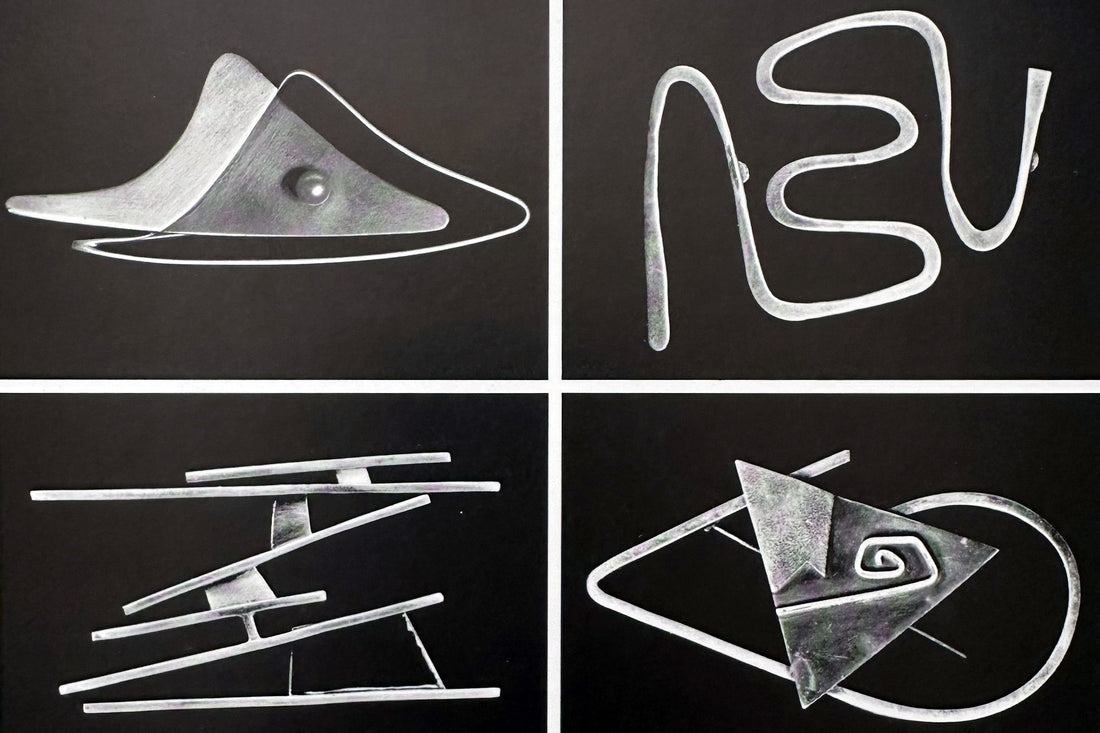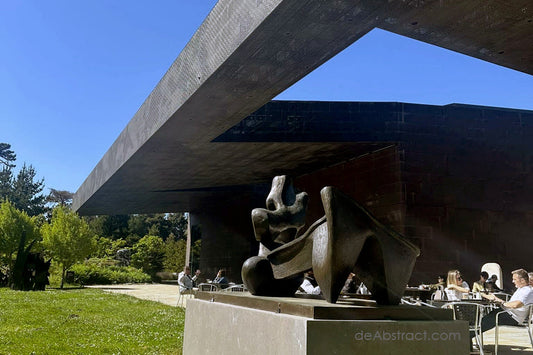
Modernist Jewelry: Wearable Avant‑Garde from Bauhaus to the Space Age.
Modernist jewelry emerged in the early 20th century as a radical departure from traditional ornamentation.
Rather than emphasizing gemstones, lavish embellishments, or status symbols, modernist jewelers treated their work as small-scale sculpture—intimate art objects meant to be worn.

- Alexander Calder, Brass Wire Earrings, c. 1942, Photographed by Alexander English.
Rooted in modernist movements such as Bauhaus, Constructivism, and Surrealism, this wave of design explored abstraction, asymmetry, movement, and the expressive potential of materials like silver, copper, ebony, quartz, and even plastic.


- Margaret DePatta, Rings (Photo 1 and 2)
One of the most influential figures of American modernist jewelry was Margaret De Patta, who studied at the Bauhaus-influenced New Bauhaus in Chicago under László Moholy-Nagy. Her designs played with light, using custom-cut crystals and rutilated quartz to create dynamic, architectural effects. Her pieces weren’t just adornments—they were optical experiments, wearable studies of form and reflection.

- Margaret DePatta, Brosh

Similarly, Sam Kramer embraced the surreal, crafting silver brooches adorned with glass eyeballs or sculptural tendrils that recalled the playful absurdities of Dada.
This era of jewelry was deeply tied to the broader ethos of modern art: that art should be democratic, functional, and deeply engaged with contemporary life.

Designers like Art Smith, based in Brooklyn, created bold, curvilinear silver forms that hugged the body and reflected the rhythms of jazz and African sculpture.
Others, like Ed Weiner or Paul Lobel, explored geometry and abstraction through highly polished metals and negative space, turning cuffs, rings, and pendants into wearable architecture.

- Henry Bertolia, Necklace
Europe and Scandinavia also played pivotal roles. In Finland, designers like Björn Weckström and Tapio Wirkkala experimented with textured silver and acrylics, creating pieces that evoked glaciers, frozen lakes, or cosmic landscapes. Weckström’s icy silver-and-acrylic necklace even made its way into popular culture when worn by Princess Leia in the original Star Wars film.

- Alexander Calder in his Paris workshop. 1930
Meanwhile, in Britain and Italy, artists like Alexander Calder, Pablo Picasso, and members of the postwar Italian avant-garde viewed jewelry as an extension of their larger sculptural or painterly practices.

- Alexander Calder necklace at the Philadelphia Museum of Art, 2008.
Modernist jewelry emphasized process and material over preciousness. Artists embraced casting techniques like lost-wax and sand-casting to create organic, brutalist textures. Industrial materials, such as Lucite or aluminum, stood proudly alongside silver or ebony, further reinforcing the modernist principle that art need not rely on luxury to be meaningful. Often made in small studios and signed by the maker, these pieces bore the marks of the artist’s hand—an intentional contrast to the mass-produced finery of commercial jewelry houses.

Today, modernist jewelry is enjoying renewed attention. Major museums have hosted retrospectives, such as the Brooklyn Museum’s exhibition on Art Smith and the Museum of Arts and Design’s show on De Patta. Auction houses now present these pieces alongside fine art, positioning them as collectible design rather than just accessories.
Collectors look for telltale signs of authenticity: hand-finished edges, asymmetrical forms, maker’s marks, and a distinct refusal to conform to traditional notions of beauty or symmetry.


- Alexander Calder, Necklace, gold and string, c. 1940. Photo: Sotheby’s (Photos 1 and 2)
Beyond their material value, these pieces stand as historical artifacts of mid-century ideals. They reflect a time when artists believed jewelry could express complex ideas about space, motion, identity, and even politics.
Whether minimalist, surreal, or boldly expressionist, modernist jewelry endures as a testament to the idea that art and life need not be separate, and that the body itself can be a moving gallery for creative expression.

- Alexander Calder, Ring made from gold wire, c. 1950. Photo: Sotheby’s




